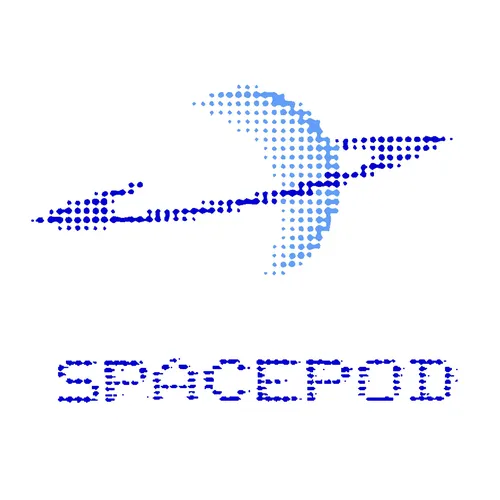
Spacepod
Hear stories about the alien moons orbiting our Sun, of cold stars, and the future of space exploration. Every week, scientist Dr. Carrie Nugent chats about an amazing part of our universe with an expert guest. Spacepod is the podcast that gives you an inside look into space exploration. Learn more: http://listentospacepod.com
- Update frequency
- every 23 days
- Average duration
- 21 minutes
- Episodes
- 231
- Years Active
- 2015 - 2025

130: Quantum entanglement with Dr. Ghose
Dr. Shohini Ghose talks about quantum entanglement, which she describes as an "amazing, weird handshake across space and time." She tells us about quantum information science, which finds useful appl…

129: A new type of galaxy with Dr. Mutlu-Pakdil
Dr. Burçin Mutlu-Pakdil talks about her amazing discovery-- a galaxy with both an inner and outer ring. The existence of such a galaxy had not been predicted before she discovered it, and there's no …

128: Sleeping on a Glacier with Dr. Koppes
Dr. Michele Koppes returns to the show to talk about her experiences studying glaciers in the field. She describes what a glacier sounds like at night, and why a good glaciologist is generally handy …

127: Black hole pairs with Dr. McGurk
Dr. Rosalie McGurk talks about her quest to find pairs of black holes. She explains how she used several different telescopes to solve this problem, narrowing the list of potential candidates from hu…

126: Supercities of the Universe with Dr. Connor
Dr. Tom Connor stops by the show to talk about massive galaxy clusters and the CLASH project. We talk about naturally occurring gravitational "telescopes" that allow us to see even farther into space…

125: Oceans, oceans everywhere with Dr. Keane
Dr. James Tuttle Keane discusses why Pluto probably has a huge underground ocean. To make this discovery, he used images of Pluto taken by the New Horizons spacecraft, computer simulations, and good …

124: Searching Antarctica for meteorites with Dr. Cohen
Dr. Barbara Cohen returns to the show to talk about meteorite collecting in Antarctica. These trips, which involve weeks of camping on the ice, provide invaluable scientific samples. She talks about …

123: Our favorite planet's future with Dr. Marvel
To celebrate Earth Day, Dr. Kate Marvel talks about models of Earth's climate. She compares many models to learn more about the way our climate works, and how it might change in the future. She also …

122: How to make a comet with Dr. Michel
Dr. Patrick Michel talks about comet 67P/Churyumov–Gerasimenko, which was visited by the Rosetta spacecraft. This comet's shape was puzzling. It looked like it had survived a collision, but how could…

121: Solar storms with Dr. Janvier
Dr. Miho Janvier talks about her work studying solar storms, and tells us about the ways these storms have impacted humans in the past. She explains why they are challenging to model and says why she…

120: Archeology for everyone with Chase Childs
Chase Childs tells us about satellite remote sensing. He explains how near-infrared images can expose underground structures, and why plant health is of surprising interest to archeologists. He also …

119: Archeology from space with Dr. Parcak
Dr. Sarah Parcak explains how she uses satellite images to locate archeological sites, and how it's her job to be a detective, piecing together clues to uncover the past. She also talks about GlobalX…

118: The stuff between the stars with Dr. Rich
Dr. Jeff Rich returns to the show to talk about the interstellar medium— all the rocks, dust, and particles that exist between the stars. After some beer, we end up talking about black holes and how …

117: Guardians of (a very small part of) the galaxy with Dr. Fast
Dr. Kelly Fast tells us about the Planetary Defense Coordination Office, which finds asteroids before they find us. She talks about a recent exercise involving the tiny asteroid 2012 TC4, where aster…

116: Extraterrestrial Seismology with Dr. Panning
Dr. Mark Panning tells us all about “earthquakes” on other worlds. He talks about the InSight mission to Mars, which carries a seismometer to detect Marsquakes. He also explains how a seismometer on …

115: Detector detective with Mario Cabrera
Mario Cabrera tells us about the specialized detectors used in professional telescopes. He talks about how he’s helping to develop new detectors that don’t require coolant and provide more science fo…

114: The densest stuff in the universe slamming together at the speed of light with Dr. Kanner
Dr. Jonah Kanner talks about LIGO’s spectacular detection of two neutron stars merging together. This merger was not only detected by gravitational wave detectors in the US and Europe, it was also se…

113: Belt and suspenders spacecraft with Julie Webster
Cassini’s spacecraft operations team manager, Julie Webster, stops by the show to reflect on Cassini. We chat about the time Cassini dove through Titan’s atmosphere, how Julie monitored thousands of …

112: Cassini Family with Dr. Cable
Dr Morgan Cable returns to the show to chat about the end of the Cassini Mission. We find solace in the fact that there’s still a tiny bit of Cassini in orbit around Saturn. Dr. Cable also describes …

111: Dust hazard with Dr. Throop
Sagan Prize winner Dr. Henry Throop tells us how scientists look for micron-sized dust that’s millions of miles away to protect the New Horizons spacecraft. This search involves computer modeling, oc…